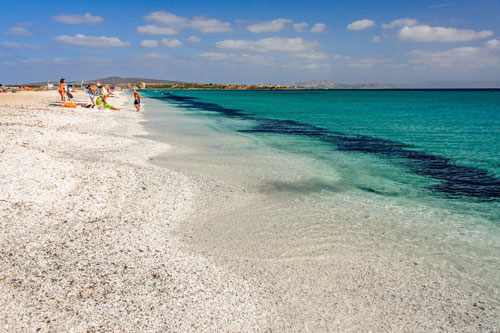Stintino Peninsula and Isola Asinara
map of Stintino Peninsula and Isola Asinara with the marked sights
Stintino

The main town of the Stintino Peninsula was established in 1885. At that time, the Italian government decided to set up a quarantine station for infected ship crews and a penal colony on the nearby Isola Asinara. The island’s residents were relocated.
Of the 54 families living on Asinara, 45 settled here, receiving compensation of 750 lire per family.
Today, the town features relatively modern buildings and straight streets.
Stintino is situated on a promontory flanked by harbors on both sides. The shape of the promontory gave the town its Sardinian name, Isthintini (meaning intestine), which was Italianized to Stintino.
The relocated fishermen long survived on tuna fishing, which is commemorated by a dedicated museum.
Tourism has since become prominent, attracting many mainland Italians, and the town gets very crowded in the summer months.
Large holiday settlements have sprung up outside Stintino.
Capo Falcone
 Capo Falcone is located about 5 km north of Stintino.
Capo Falcone is located about 5 km north of Stintino.
Before the area was designated a nature reserve, a large holiday settlement was established here. In summer, residents and numerous day-trippers create a massive influx.
The small beaches of Pelosa and Pelosetta have become especially popular among Italians.
Despite high parking fees, finding a spot in peak season is challenging, and the beaches are extremely crowded.
However, the trip is worthwhile due to the stunning scenery. From the rugged rocks above the beaches, you get a magnificent view of the small Isola della Pelosa with its Spanish watchtower, and further out, the Isola Asinara.
You can scramble around the rocky landscape and take impressive photos of the crashing waves, especially on stormy days.
Spiaggia delle Saline

Spiaggia delle Saline is located a bit south of Stintino on the east side of the peninsula.
It is part of a roughly 7 km long coastal strip with several beaches. During the season, there are bars, sunbed and umbrella rentals, and pedal boats for hire.
The beach is made of light pebbles, transitioning to fine sand in the water after a few meters.
In summer, it is mainly frequented by residents of the nearby holiday settlement, but if you walk a bit from the large parking areas, you can still find a quiet spot.
The west coast of the Stintino Peninsula, in contrast, is mostly composed of high cliffs that drop steeply to the sea, offering limited access to the water and making it unsuitable for leisurely swimming.
Bunkers
 Bunkers from World War II are scattered across the Stintino Peninsula and further south towards Alghero.
Bunkers from World War II are scattered across the Stintino Peninsula and further south towards Alghero.
Sardinia was an important military base for the Axis powers Italy and Germany. During the Africa campaign, significant parts of the supply lines ran through the island. Sardinia was repeatedly bombarded by the British and Americans.
The primary task of the German Sardinia Division was to prevent an Allied landing, which ultimately occurred in Sicily.
As the war progressed, the Allies advanced on the Italian mainland, leading to Italy’s capitulation and declaration of war on Germany.
This created a difficult situation for the German troops on Sardinia, as their former Italian allies became enemies.
On September 10, 1943, the evacuation of German troops began. The Italians allowed an honorable withdrawal as a gesture of former camaraderie, with soldiers retaining light weapons and no combat occurring.
Isola Asinara

In 1885, a penal colony was established in Cala d’Oliva and a quarantine station in Cala Reale on Isola Asinara. The existing population, about 500 people, consisting half of fishermen and half of shepherds, had to leave the island.
The prisoners engaged in agriculture, animal husbandry, and cheese production.
During both World Wars, POW camps were also set up, and malaria was rampant among the prisoners due to undrained swamps.
In the 1970s, a high-security prison for convicted Mafiosi and terrorists was built in Fornelli.
The island’s buildings today mostly include former administrative offices, prisons, barracks for guards, and a hospital.
Due to its isolation, the island’s flora and fauna developed relatively undisturbed. To protect this, a national park was established in 1997 after the prison closures. The island has been open to the public since 1999.

Most visitors come to the island on guided day trips by boat from Stintino.
A small train takes you from Fornelli to Cala d’Oliva, with tours conducted in Italian. Bathing stops are usually possible; inquire with providers in Stintino.
You can see the penal colony buildings, a former monastery cemetery, and the high-security prison.
Individual tours on foot or by bike are also available; for more information, visit www.parcoasinara.org.
The island is home to the famous white donkeys, a breed that once also lived in other parts of Sardinia and suffers from congenital albinism.
They have become accustomed to tourists.
The island’s name, incidentally, does not derive from asino (donkey) but from sinuoso (winding), referring to the island’s shape.
